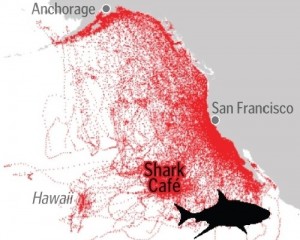Census of Marine Life, Washington DC / Tagging of Pacific Palagics project, Pacific Grove, CA
22 June 2011
Decade of electronic tagging, tracking of 23 top Pacific Ocean predators reveals remarkable homing by marine animals, well-defined highways

Tracking the paths of ocean predators Many species of Pacific predators stick to familiar routes each season, according to new findings of a decade-long study that tracked 23 types of marine animals. The two most heavily trafficked corridors are the California Current along the West Coast of the U.S. and the North Pacific Transition Zone, where cold and warm water meet halfway between Alaska and Hawaii.
Like the vast African plains, two huge expanses of the North Pacific Ocean are major corridors of life, attracting an array of marine predators in predictable seasonal patterns, according to final results from the Census of Marine Life Tagging of Pacific Predators (TOPP) project published today in the journal Nature.
The paper culminates the TOPP program’s decade-long effort to track top marine predator movements in the Pacific Ocean. It presents for the first time the results for all 23 tagged species and reveals how migrations and habitat preferences overlap — a remarkable picture of critical marine life pathways and habitats.
The study found that major hot spots for large marine predators are the California Current, which flows south along the US west coast, and a trans-oceanic migration highway called the North Pacific Transition Zone, which connects the western and eastern Pacific on the boundary between cold sub-arctic water and warmer subtropical water — about halfway between Hawaii and Alaska.
“These are the oceanic areas where food is most abundant, and it’s driven by high primary productivity at the base of the food chain — these areas are the savanna grasslands of the sea,” say co-authors and project originators Barbara Block of Stanford University’s Hopkins Marine Station and Daniel Costa, professor of ecology and evolutionary biology at the University of California, Santa Cruz.
“Knowing where and when species overlap is valuable information for efforts to manage and protect critical species and ecosystems.”
Full news release: click here
Coverage summary: click here
Example coverage, by Washington Post: click here; more sources, click here